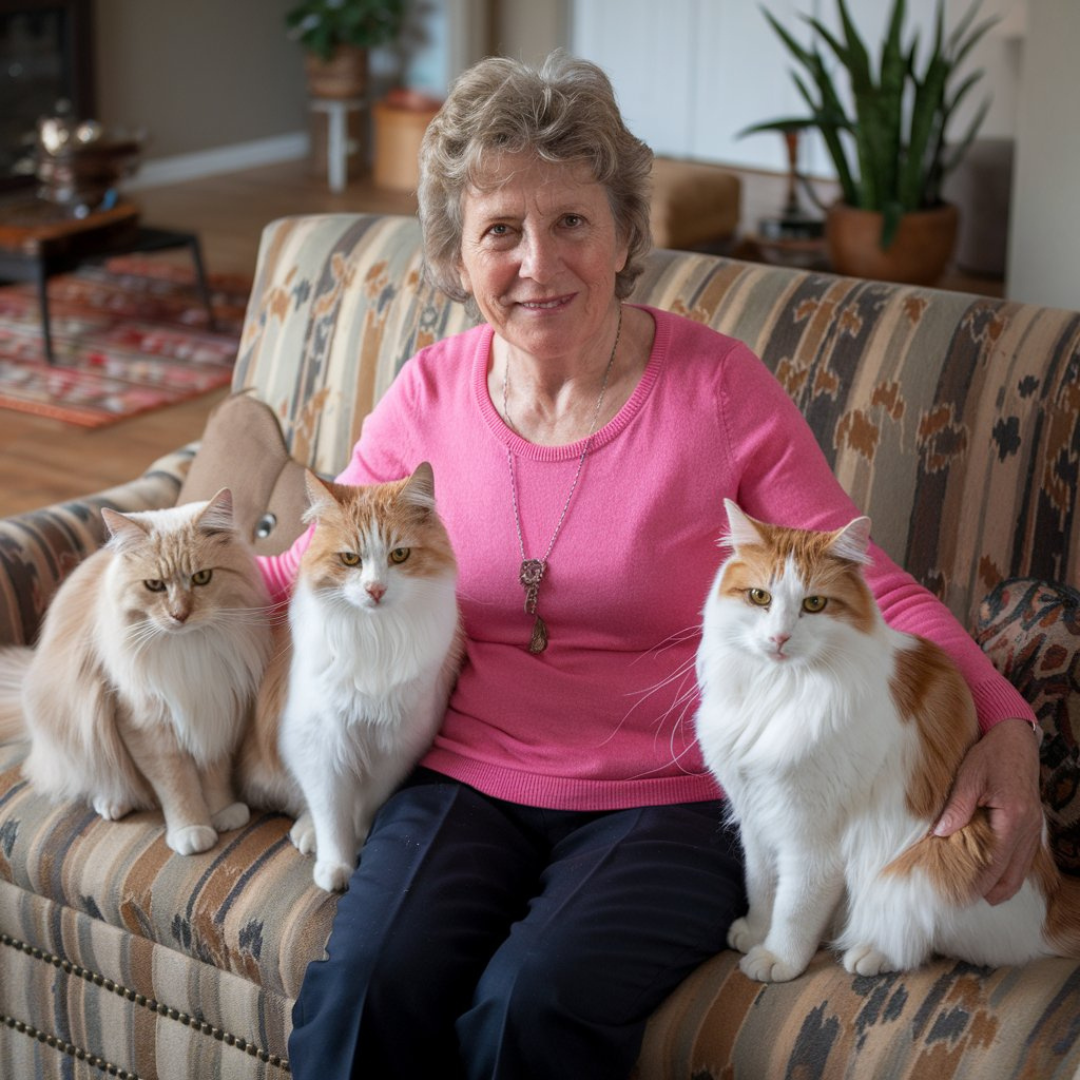Retired nurse Margaret Wilson never imagined that her golden years would be filled with purring companions and whiskers tickling her face at dawn. Yet, after 45 years of caring for human patients, she found herself on an unexpected journey, fostering senior cats who, like her, were in their twilight years but still had so much love to give.
A New Chapter Begins
Three years ago, Margaret’s home felt eerily quiet. After losing her husband Robert to cancer and watching her children move across the country for their careers, the silence became her constant companion.
The retired critical care nurse who had spent decades comforting others found herself struggling with her own healing. “I felt useless,” Margaret admits. “My hands that had helped so many patients suddenly had nothing meaningful to do.”
That changed on a rainy Tuesday when she visited her local animal shelter, intending only to make a small donation. As she waited at the reception, a volunteer walked past with a gray-faced tabby cat with cloudy eyes.
Something clicked in Margaret’s mind that day. “I know what it’s like to be considered past your prime,” she said, reaching out to stroke Charlie’s weathered face.
Finding Purpose in Paws
Margaret took Charlie home that afternoon as a foster cat. With her nursing background, she wasn’t intimidated by his arthritis medication schedule or special diet needs. Instead, these caregiving tasks gave her mornings structure and purpose.
Within weeks, Charlie blossomed under Margaret’s care. His coat grew shinier, and he moved more comfortably around her small bungalow. When the shelter called to check if he was ready to be put up for adoption, Margaret couldn’t bear the thought.
“I’ll be keeping him,” she said firmly, becoming what the shelter affectionately calls a “foster failure” someone who ends up adopting their foster animal.
But rather than truly failing, this moment launched Margaret’s new calling. She decided her home and heart had room for more temporary residents who needed specialized care before finding their forever homes.
The Senior Cat Sanctuary
Two years later, Margaret’s home has been carefully transformed into what neighborhood children call “The Senior Cat Sanctuary.” Her sunroom now features gently sloped ramps for arthritic joints, heated beds for aging bones, and strategically placed water bowls for cats with mobility issues.
“I’ve fostered twenty-three senior cats now,” Margaret says, beaming with quiet pride. “Seventeen have found permanent homes, often with other retirees who understand that gray muzzles come with the richest purrs.”
The shelter staff frequently call Margaret for cats with medical needs that match her expertise. She’s become particularly skilled with diabetic cats who need insulin injections and monitoring.
“My nursing skills transferred perfectly,” she explains. “I can spot subtle changes in behavior that might indicate pain or illness before they become serious problems.”
Mutual Healing
What began as Margaret offering help to forgotten felines quickly revealed itself as a two-way street of healing. The cats needed her, yes, but she needed them just as much.
“After Robert died, I struggled with insomnia,” Margaret confesses. “But it’s hard to stay awake worrying when you have a purring cat on your chest and another warming your feet.”
The routine of caring for her feline charges also gave Margaret’s days structure. Morning medications, feeding schedules, playtime, and grooming sessions filled her hours with purpose. The silence that once haunted her home has been replaced by the gentle symphony of purrs, meows, and the occasional knocked-over water glass.
Studies have long shown that pets can lower blood pressure and reduce anxiety, but for Margaret, the benefits went deeper. “When you’re caring for someone who truly needs you, it’s impossible to feel useless,” she explains.
Creating New Connections
Margaret’s fostering work has also rebuilt her human connections. She started a blog documenting her senior cat adventures, which caught the attention of her local news. After a feature story about her work, volunteer applications at the shelter increased by thirty percent.
She now hosts monthly “Senior Cat Socials” where potential adopters can meet older cats in a home environment. These gatherings have created a community of senior pet enthusiasts who share resources, stories, and sometimes, pet-sitting duties.
“I’ve made more friends in my seventies than I did in my sixties,” Margaret laughs. “And they’re people who understand that both cats and humans deserve love at every age.”
Her daughter Jenny, who initially worried about her mother living alone, has noticed the transformation. “Mom texts me cat photos instead of worrying about her health now,” she says. “These cats gave her back her joy.”
Lessons from Nine Lives
When asked what her cats have taught her, Margaret’s eyes fill with tears. “They’ve shown me that it’s never too late to start again,” she says softly. “These cats don’t dwell on their past hardships. They don’t worry about how much time they have left. They simply soak up the sunshine when it’s available and purr when they’re content.”
She’s learned to approach her own aging with similar wisdom. “Every morning, I wake up and stretch just like they do,” she smiles. “I take my pills when they take theirs. And I remind myself that today is a gift, not a guarantee.”
Margaret’s latest foster, a 15-year-old calico named Pepper with a heart condition, watches from her lap as we talk. “The shelter warned me she might only have months left,” Margaret says, gently stroking the cat’s ear. “But that just means those months should be filled with as much comfort and love as possible.”
It’s a philosophy that has not only healed the cats in her care but has healed Margaret herself—proving that sometimes, the best medicine comes with four paws, a tail, and the wisdom that only senior souls can share.

